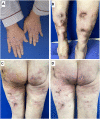Recurrent Skin and Soft Tissue Infections Caused by Ureaplasma urealyticum in an Immunocompromised Adult Patient: A Case Report
- PMID: 36465813
- PMCID: PMC9717603
- DOI: 10.2147/IDR.S390096
Recurrent Skin and Soft Tissue Infections Caused by Ureaplasma urealyticum in an Immunocompromised Adult Patient: A Case Report
Abstract
Ureaplasma urealyticum (U. urealyticum) is a normal commensal that colonizes the human genital tract and usually of low virulence; however, it can trigger serious extragenital infections in immunocompromised patient. In this case, a 48-year-old female immunocompromised patient with a four-year history of recurrent ulcer on extremities was presented to our hospital due to aggravation of lesions 10 months before. She was initially diagnosed as Pseudomonas aeruginosa infection secondary to lupus panniculitis and slightly responded to ceftazidime treatment; however, a new rash appeared on her left hip 16 days after admission, which was aggravated even under antibiotic treatment. After multiple negative cultures, U. urealyticum was identified in her left hip tissue using metagenomic next-generation sequencing (mNGS). U. urealyticum was also confirmed in her secretion samples from left hip, left thigh, right calf and uterine neck using mycoplasma culture and quantitative real-time polymerase chain reaction. Her lesions, especially the new rash, were positively responded to sensitive antibiotic treatment. To the best of our knowledge, this is the first case of U. urealyticum induced recurrent skin and soft-tissue infections (SSTIs) in an immunocompromised adult patient. This case suggests that the prevalence of this kind of infections may be underestimated because of the limitation of routine culture. mNGS may be considered to look for atypical pathogens to improve the antimicrobial treatment of complicated infections.
Keywords: Ureaplasma urealyticum; extragenital infection; immunocompromised; metagenomic next-generation sequencing; skin and soft-tissue infection.
© 2022 Zhang et al.
Conflict of interest statement
The authors report no conflicts of interest in this work.
Figures



Similar articles
-
Diagnostic Value of Metagenomic Next Generation Sequencing for Ureaplasma urealyticum Infection: A Case Report.Lab Med. 2022 Jul 4;53(4):e74-e76. doi: 10.1093/labmed/lmab091. Lab Med. 2022. PMID: 34668543
-
Ureaplasma urealyticum disseminated multifocal abscesses in an immunocompromised adult patient: a case report.BMC Infect Dis. 2020 Jan 15;20(1):47. doi: 10.1186/s12879-020-4771-z. BMC Infect Dis. 2020. PMID: 31941460 Free PMC article.
-
Ureaplasma urealyticum necrotizing soft tissue infection.J Infect Chemother. 2017 Dec;23(12):830-832. doi: 10.1016/j.jiac.2017.07.007. Epub 2017 Aug 10. J Infect Chemother. 2017. PMID: 28803865
-
Should we be testing for urogenital Mycoplasma hominis, Ureaplasma parvum and Ureaplasma urealyticum in men and women? - a position statement from the European STI Guidelines Editorial Board.J Eur Acad Dermatol Venereol. 2018 Nov;32(11):1845-1851. doi: 10.1111/jdv.15146. Epub 2018 Jul 6. J Eur Acad Dermatol Venereol. 2018. PMID: 29924422 Review.
-
Association between genital mycoplasmas infection and human papillomavirus infection, abnormal cervical cytopathology, and cervical cancer: a systematic review and meta-analysis.Arch Gynecol Obstet. 2018 Jun;297(6):1377-1387. doi: 10.1007/s00404-018-4733-5. Epub 2018 Mar 8. Arch Gynecol Obstet. 2018. PMID: 29520664
References
Publication types
LinkOut - more resources
Full Text Sources

